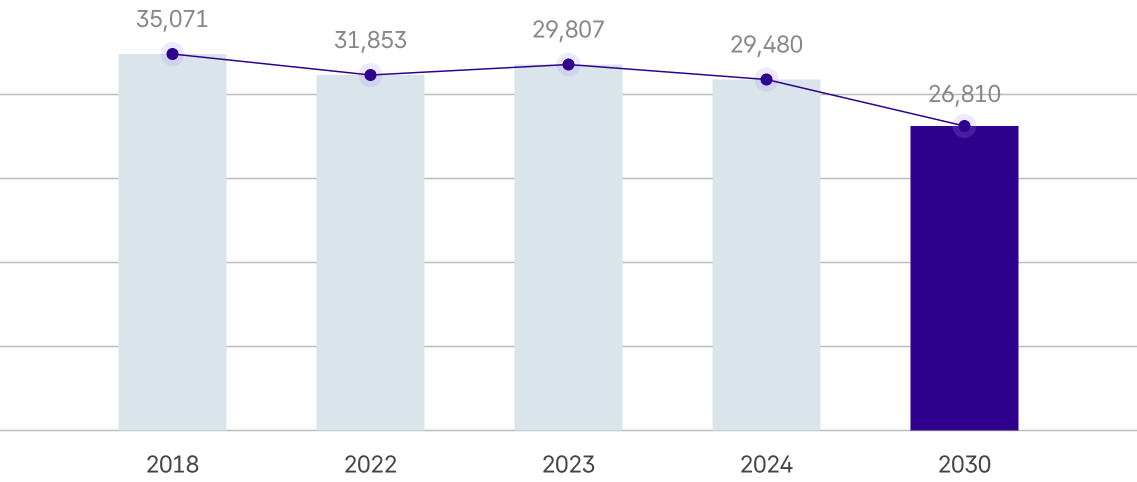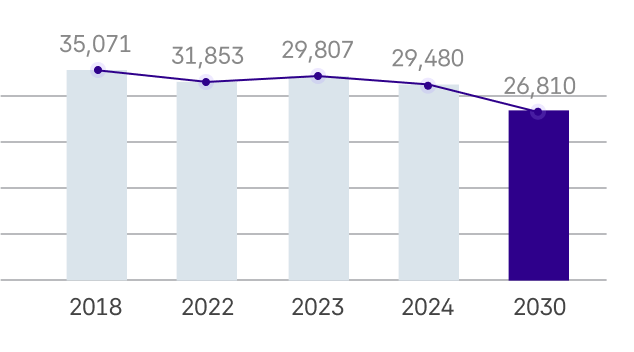Environmental
Climate Response
Tackling climate change is an essential task for not only the present generation, but also the survival of future generations.
As a global company engaged in diverse business activities, including textiles, chemicals, heavy industries, and IT equipment and services,
Hyosung clearly recognizes that greenhouse gas emissions and energy consumption across the entire business value chain significantly affect climate change and the climate crisis.
Hyosung supports the carbon neutrality policies of the international community and the Korean government, and is committed to addressing climate change.
Climate Change Response Strategy
Link CopyGreenhouse gas Reduction Target
Based on the manufacturing of fibers, heavy industries, and chemicals, Hyosung makes various efforts throughout its management with a sense of social responsibility to minimize the impact of climate change. We make various efforts throughout our management to reduce this impact.
In order to meet the nationally determined contribution (NDC) goals of the Korean industrial sector announced in 2021, Hyosung Corporation’s Green Management Vision 2030 aims to reduce greenhouse gas emissions by 14.5% compared to 2018. In April 2023, Hyosung Corporation revised its target to reduce emissions by 23.6% by 2030 compared to 2018 levels.
To achieve the target, we establish and implement an annual facility investment plan for energy reduction, and all relevant departments, including planning, research, production, and power generation, formulate plans for mid- to long-term reduction goals and provide regular updates to the ESG Management Promotion Committee and the Board of Directors.
- 2018
- 35,071
- 2022
- 31,853
- 2023
- 29,807
- 2024
- 29,480
- 2030
- 26,810


Mid- to-Long-term Climate Action Roadmap

| Category | 2018 | 2022 | 2023 | 2024 | 2025 | 2026~2029 | 2030 | |
|---|---|---|---|---|---|---|---|---|
| Goals (Parent Company) | Hyosung Corporation | Base Year | Gradual annual reduction of 1.0–4.0% | 23.6% Reduction | ||||
| Operating Companies | Annual 1.2% reduction (under review for increase) | 14.5% Reduction | ||||||
| Detailed Implementation Plan | Greenhouse Gas Inventory Development | Scope 1&2 | Manufacturing Companies | Major Subsidiaries | All Subsidiaries | |||
| Scope 3 | Parent Company | Manufacturing Companies | Major Subsidiaries | |||||
| Lead agency for emissions calculation | Parent Company | Subsidiaries | ||||||
| Risk and Opportunity Identification & Assessment | Physical Risk (SSP5-8.5) | Parent Company | Manufacturing Companies | Major Subsidiaries | ||||
| Transition Risk (Based on revised Korean 2030 NDC & Carbon Neutrality Scenario): | Parent Company | Manufacturing Companies | Major Subsidiaries | |||||
| Reduction Implementation | Fuel switching, high-efficiency equipment replacement, process improvement | |||||||
| Renewable energy generation or purchase | ||||||||
| Raw material transition | ||||||||

** This roadmap is subject to change depending on the business conditions of each operating company.
Climate Change Management
Link CopyRisk Management Process
Hyosung Corporation has established and operates a risk management process that can identify risks and opportunities related to climate change and systematically respond to changes in the market and technology.
Each year, Hyosung Corporation updates its risk management status in order to identify new risks and enhance the concreteness of its countermeasures. Significant risks are reported to the ESG Management Promotion Committee and assessed annually to determine if countermeasure objectives have been met.
Risk/Opportunity Factor Analysis and Response Plan
Hyosung Corporation identified and assessed risks and opportunities based on the climate risk classification system included in the TCFD framework, and established response strategies to proactively respond to climate crises.
We identified the transition risks, physical risks, and opportunity factors that companies are facing due to climate change, and based on them, we identified the financial impact of each factor on their business activities.
Detailed information on this matter is available in our Sustainability Report
Climate Change Indicator Management
- Operation of carbon asset management system
- Since 2011, Hyosung has implemented and operated an IT-based carbon asset management system to monitor greenhouse gas emissions at each business site.
- Using the system, we establish a Greenhouse Gas inventory at each business site and ensure systematic management by monitoring emissions by facility and activity data in accordance with the Emissions Calculation Plan.
- In addition, we implemented a system for calculating the carbon footprint of products in June 2022 so as to measure and manage carbon emissions throughout the product life cycle.
- Management of climate change-related employee key performance indicators (KPIs) and incentives
- As performance indicators, Hyosung establishes energy reduction goals for production executives or plant managers relating to climate change, and greenhouse gas reduction goals for members of the Green Management Team. Their performances are evaluated so they are awarded incentives based on the evaluation outcomes. Moreover, in order to establish ESG management as a part of the corporate culture, the ESG Management Promotion Committee and the Board of Directors decided in 2021 to establish ESG management KPIs for employees and evaluate their performance. The initiative has been implemented since 2022. Accordingly, we have set up climate change indicators to evaluate all teams associated with energy conservation and greenhouse gas reduction, such as the ESG Management Team, Green Management Team, Production Team, and Power Generation Team, as well as relevant executives (including C-level).
- Internal Carbon Pricing
- In 2021, Hyosung introduced internal carbon pricing in order to identify risks and opportunities associated with climate change as a result of the transition to a low-carbon economy. We use this information for company-wide business direction and investment decisions. Internal carbon pricing entails the company voluntarily internalizing the economic cost of greenhouse gas emissions by establishing a price for carbon emitted from management and business activities. Accordingly, Hyosung converts both the amount of carbon emitted and the amount of carbon emissions cut resulting from energy savings into a monetary value, incorporates it into economic evaluation, and uses it for energy facility replacement, new business expansion, and business investment.
Climate Action
Link Copy-
Greenhouse gas reduction activities
Hyosung continues to promote the use of environmentally friendly fuel, the replacement with high-efficiency equipment,
the enhancement of processes, and the introduction of environmentally friendly equipment.In particular, as approximately 70% of Hyosung Corp.’s total greenhouse gas emissions result from electricity consumption,
the company is implementing electricity reduction measures as a core strategy for emissions reduction. - Building smart factories
- Support for energy conservation and Greenhouse Gas reduction for partners
- Internal contest for energy conservation and Greenhouse Gas reduction idea submissions
- Environmental education targeting all employees
- Stakeholder Engagement on Climate Crisis Awareness
Climate Initiatives
Link Copy
Hyosung Corporation declared its support for the Task Force on Climate-related Financial Disclosures (TCFD) in 2022 as part of its commitment to international cooperation on climate crisis response.
It also publishes a sustainability report aligned with TCFD recommendations.
Additionally, Hyosung corporation participates in the Textile Industry Greenhouse gas Reduction Research


